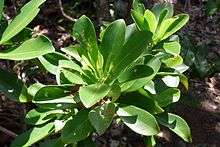Halfordia kendack
| Halfordia kendack | |
|---|---|
 | |
| Saffronheart in a rainforest at Byron Bay, Australia | |
| Scientific classification | |
| Kingdom: | Plantae |
| (unranked): | Angiosperms |
| (unranked): | Eudicots |
| (unranked): | Rosids |
| Order: | Sapindales |
| Family: | Rutaceae |
| Genus: | Halfordia |
| Species: | H. kendack |
| Binomial name | |
| Halfordia kendack | |
| Synonyms | |
| |
Halfordia kendack is a rainforest tree in the citrus family, found in eastern Australia. Common names include saffronheart, kerosenewood and southern ghittoe. The natural distribution is from Woolgoolga in New South Wales to many parts of coastal Queensland, Torres Strait and also New Caledonia.
This plant was collected by Ludwig Leichhardt at Moreton Bay and Charles Moore at Cape Byron. Halfordia is named after George Britton Halford, "kendack" may be an indigenous name for this tree in New Caledonia.
Habitat
Often seen near the ocean in littoral rainforest. But it also grows at higher altitudes in sub tropical and tropical rainforests.
Description
A tree to 25 metres in height[1] and 75 cm in trunk diameter. The base of the tree is often flanged. The bark is grey, or yellow/brown with corky pustules, often rough and wrinkled. Small branches are green and smooth, around 13 mm thick.
Leaves
Leaves are 5 to 18 cm long, 1 to 5 cm wide, arranged alternatively on the stem. Leaf shape is reverse ovate or reverse lanceolate. The leaf tip has an obtuse point. Oil dots may be easily noticed under a lens, or seen without a lens with direct sunlight. The leaf stem is 3 to 20 mm long, with a swollen base. New leaves have a noticeable aromatic scent, resembling eau de cologne.[2] Leaf veins are somewhat raised on the upper surface, more so below the leaf.
Flowers & fruit
Creamy flowers form between December and March. Individual flowers are around 11 mm in diameter. Fruit is a dark drupe, purple, dark blue or black, 12 mm long. The hard seed is surrounded by pulp, which is eaten by a variety of birds, such as the green catbird, topknot pigeon and wompoo fruit dove. Germination from seeds can be difficult, often erratic.[3]
Uses
Before the development of fibreglass and carbon fibre, the timber of this species was used in the manufacture of fishing rods. The oily, flexible timber is hard, weighing 1100 kg per cubic metre. This plant is gaining popularity in horticulture.[4] The wood is highly flammable, and chips of wood may be used to start a fire, even when wet, hence one of the common names, "kerosene wood".
References
- ↑ "Halfordia kendack". PlantNET — NSW Flora Online. Retrieved 2016-10-24.
- ↑ "A Mystery Tree Bears Fruit by Jane Sked". Australian Plants Online 2009 Australian Native Plants Society (Australia). Retrieved 2016-10-24.
- ↑ Floyd, A.G. (2008). Rainforest Trees of Mainland South-eastern Australia (2nd ed.). Inkata Press. p. 363. ISBN 978-0-9589436-7-3. 363
- ↑ "Halfordia kendack". Australian Tropical Rainforest Plants. Retrieved 2016-10-24.
External links
- "Halfordia kendack (Montrouz.) Guillaumin". Atlas of Living Australia.